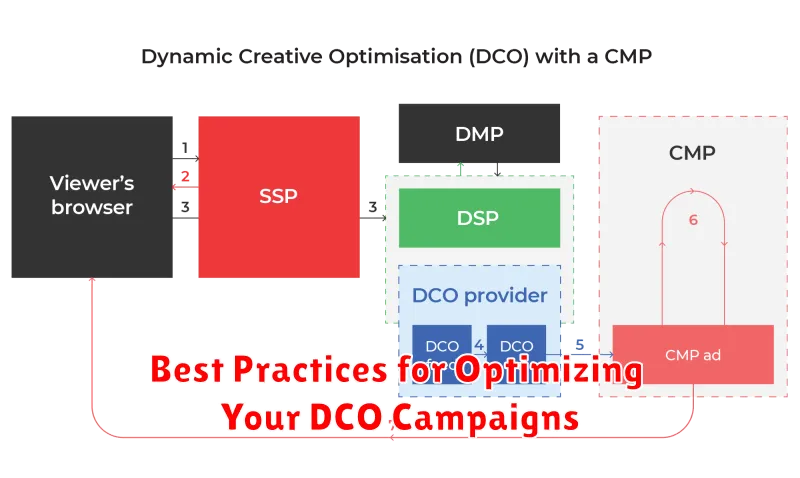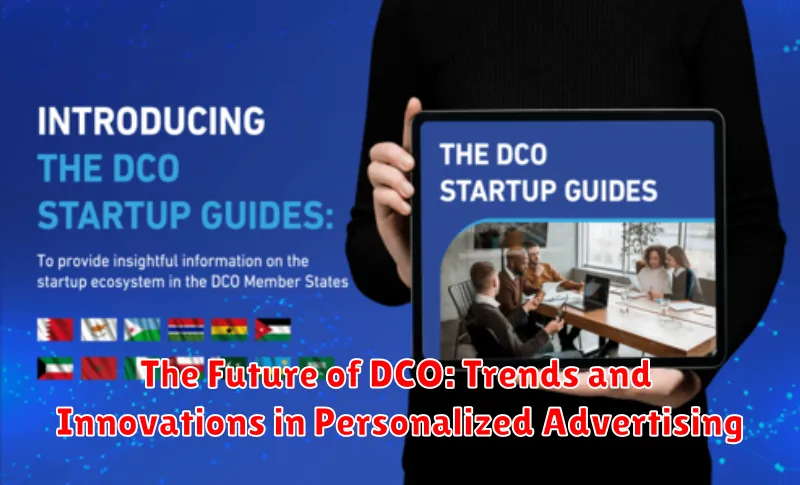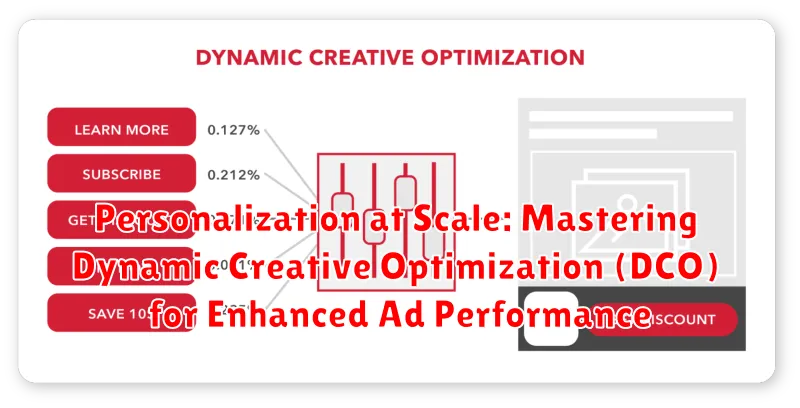In today’s fiercely competitive digital landscape, achieving peak ad performance demands more than just broad-stroke targeting. The era of generic advertising is waning, replaced by a need for hyper-relevance and personalized experiences. Enter Dynamic Creative Optimization (DCO), a revolutionary approach to advertising that leverages data and technology to deliver personalization at scale. This article delves into the core principles of DCO, exploring how it empowers marketers to craft uniquely tailored ad experiences that resonate with individual users, ultimately driving higher engagement and conversion rates globally.
This comprehensive guide aims to equip readers with the knowledge and strategies necessary to master DCO and unlock its full potential. We’ll explore the key components of a successful DCO campaign, from understanding audience segmentation and data-driven insights to implementing effective creative optimization techniques. Furthermore, we will showcase how personalization at scale, powered by DCO, can be implemented across various platforms and industries, leading to significantly enhanced ad performance and a stronger return on investment (ROI). Whether you are a seasoned marketing professional or just beginning to explore the possibilities of personalized advertising, this article will provide valuable insights and actionable strategies to elevate your advertising efforts.
What is Dynamic Creative Optimization (DCO) and How Does It Work?
Dynamic Creative Optimization (DCO) is an advanced advertising technology that leverages data and algorithms to automatically generate and serve personalized ad creatives to individual users in real-time. Instead of relying on static ad designs, DCO platforms create variations of ad elements like headlines, images, calls-to-action, and even product recommendations.
The DCO process typically involves these key steps:
- Data Collection: Gathering user data from various sources (e.g., website behavior, CRM, demographics).
- Creative Asset Upload: Uploading a library of creative assets (images, headlines, descriptions, etc.).
- Rule Setting: Defining rules within the DCO platform to dictate which creative elements should be displayed based on specific user attributes or behaviors.
- Real-Time Optimization: The DCO engine continuously analyzes ad performance and automatically adjusts creative combinations to maximize key performance indicators (KPIs) such as click-through rates (CTR) and conversion rates.
- Reporting and Analytics: Providing detailed reports on creative performance, allowing marketers to understand which ad variations are most effective for different audience segments.
By dynamically tailoring ad creatives, DCO aims to deliver more relevant and engaging experiences, ultimately leading to improved advertising ROI.
The Key Benefits of Implementing DCO in Your Advertising Campaigns
Implementing Dynamic Creative Optimization (DCO) offers several significant advantages for advertising campaigns. Primarily, DCO leads to improved ad performance by delivering personalized and relevant ad experiences to individual users. This personalization drives higher engagement rates, including click-through rates (CTR) and conversion rates.
Another key benefit is enhanced efficiency. DCO automates the process of creating and serving ad variations, reducing the manual effort required to manage numerous campaigns. This automation also allows for real-time optimization based on performance data, ensuring that the most effective ad combinations are consistently displayed. Ultimately, DCO enables advertisers to achieve a higher return on investment (ROI) by optimizing ad spend and maximizing the impact of their campaigns.
Understanding the Core Components of a DCO Platform
A Dynamic Creative Optimization (DCO) platform is a complex system with several vital components working in concert to deliver personalized advertising experiences at scale. Understanding these components is crucial for effectively leveraging DCO.
Key Components:
- Creative Asset Library: This is where all your ad elements (images, videos, headlines, calls-to-action) are stored and organized. Efficient management of assets is critical.
- Decision Engine: The brain of the platform, it uses algorithms and rules to determine the optimal creative combination for each individual user based on available data.
- Data Integration Layer: This component connects the DCO platform to various data sources (CRM, DMP, website analytics) to gather user insights.
- Reporting and Analytics Dashboard: Provides real-time performance data, allowing marketers to monitor campaign effectiveness and identify areas for optimization.
- Testing and Optimization Tools: A/B testing and multivariate testing features are essential for continuously improving creative performance.
Without these components, the ability to deliver personalized ads efficiently and effectively would be severely compromised.
Data Sources for DCO: Leveraging Insights for Personalization
Dynamic Creative Optimization (DCO) relies heavily on data to deliver personalized ad experiences. The effectiveness of DCO campaigns hinges on the quality and variety of data sources utilized. These sources provide the insights necessary to tailor ad content to individual users, maximizing engagement and conversion rates.
Key data sources include:
- First-Party Data: Directly collected from your website, app, or CRM. This includes browsing behavior, purchase history, demographic information, and email interactions.
- Second-Party Data: Data shared by trusted partners or affiliates, providing access to audience segments and insights beyond your own customer base.
- Third-Party Data: Data aggregated from various sources by external providers, offering broad demographic, interest-based, and behavioral targeting options.
- Contextual Data: Real-time information about the user’s current browsing environment, such as website content, device type, and location.
By integrating and analyzing these data sources, DCO platforms can identify relevant user attributes and preferences, dynamically adjusting ad creative elements like headlines, images, and calls-to-action to resonate with each individual user. The more comprehensive and accurate the data, the more effective the personalization will be.
Creative Strategies for Effective DCO Campaigns
Developing compelling creative strategies is essential for maximizing the impact of DCO campaigns. These strategies ensure that personalized ads resonate with individual users, driving engagement and conversions.
A/B Testing with DCO
A/B testing is crucial. Run concurrent variations of ad elements such as headlines, images, and calls to action to identify which combinations perform best for different audience segments.
Leveraging Dynamic Content Elements
Utilize dynamic content elements effectively. This includes personalized product recommendations, localized messaging, and offers tailored to user demographics or browsing behavior.
Storytelling and Emotional Connection
Craft narratives that resonate with your audience. Use storytelling techniques to create emotional connections, making your ads more memorable and impactful. Focus on highlighting the benefits that are most relevant to each user.
Personalized Visuals
Incorporate personalized visuals that reflect user preferences or past interactions with your brand. Use data insights to select images and videos that align with user interests.
How to Set Up and Launch Your First DCO Campaign
Launching your first Dynamic Creative Optimization (DCO) campaign involves a structured approach to ensure optimal performance. Begin by defining your campaign goals and target audience. This will inform the creative variations and data sources you’ll need.
Step-by-Step Guide:
- Define Your Objectives: Clearly outline what you want to achieve with your DCO campaign (e.g., increase conversions, improve brand awareness).
- Identify Your Target Audience: Segment your audience based on relevant data points (e.g., demographics, interests, behaviors).
- Develop Creative Assets: Create multiple variations of your ad elements (headlines, images, calls-to-action) that align with different audience segments.
- Configure Your DCO Platform: Set up the rules and logic within your chosen platform to dynamically serve the appropriate ad variations to each user.
- Integrate Data Sources: Connect your data sources (e.g., CRM, website analytics) to the platform to personalize ads based on real-time insights.
- Launch and Monitor: Deploy your campaign and continuously monitor its performance, making adjustments as needed to optimize results.
Thoroughly testing your creative variations and platform configurations before the full launch is crucial for identifying any potential issues and ensuring a smooth and effective campaign rollout.
Measuring the Success of Your DCO Campaigns: Key Performance Indicators (KPIs)
To effectively gauge the impact of Dynamic Creative Optimization (DCO) campaigns, a focused approach to Key Performance Indicators (KPIs) is essential. These metrics provide valuable insights into the performance and effectiveness of personalized advertising efforts.
Key KPIs to Monitor
- Click-Through Rate (CTR): Measures the percentage of users who click on an ad after seeing it. A higher CTR indicates more engaging and relevant creative.
- Conversion Rate: Tracks the percentage of users who complete a desired action (e.g., purchase, sign-up) after clicking on an ad.
- Cost Per Acquisition (CPA): Determines the cost associated with acquiring a new customer or achieving a specific conversion goal.
- Return on Ad Spend (ROAS): Calculates the revenue generated for every dollar spent on advertising.
- Engagement Metrics: Includes metrics such as time spent on landing pages, video completion rates, and social shares, reflecting user interaction with the ad content.
By consistently monitoring these KPIs, marketers can gain a comprehensive understanding of their DCO campaigns’ performance and make data-driven optimizations to improve results.
Best Practices for Optimizing Your DCO Campaigns

To maximize the effectiveness of your Dynamic Creative Optimization (DCO) campaigns, adherence to best practices is crucial. Consistent monitoring and refinement are key.
A/B Testing Rigorously
Conduct thorough A/B testing of various creative elements, including headlines, images, and calls to action. Utilize statistical significance to ensure accurate results before implementing changes broadly.
Data-Driven Iteration
Regularly analyze campaign performance data to identify underperforming creative assets. Replace or modify these elements based on insights derived from the data. Ensure your data sources are accurate and up-to-date.
Audience Segmentation Refinement
Continuously refine your audience segments based on performance data. Segment your audience into smaller, more defined groups to enhance personalization accuracy. Consider factors such as demographics, interests, and behavior.
Creative Fatigue Mitigation
Monitor your campaigns for signs of creative fatigue. Refresh your creative assets frequently to maintain audience engagement and prevent ad blindness. Implement a rotation schedule for your ad creatives.
Platform Feature Utilization
Leverage all available features and capabilities within your DCO platform. Explore advanced targeting options, reporting tools, and integration possibilities to optimize campaign performance. Stay informed about platform updates and new features.
Real-World Examples of Successful DCO Implementations
Numerous companies have witnessed substantial improvements in their advertising performance through the strategic implementation of Dynamic Creative Optimization (DCO). These successes provide tangible evidence of DCO’s effectiveness in driving engagement and conversions.
Consider a leading e-commerce retailer. By utilizing DCO, they personalized ad creatives based on user browsing history, purchase behavior, and demographic data. This resulted in a 25% increase in click-through rates (CTR) and a 15% boost in conversion rates compared to their standard static ads.
Another compelling example involves a financial services company. They deployed DCO to tailor messaging around specific financial products based on user income level, investment preferences, and life stage. This approach led to a 40% improvement in qualified leads generated through their digital advertising efforts.
These are just a few examples. DCO empowers brands to deliver highly relevant and engaging ad experiences, driving meaningful results across various industries.
The Future of DCO: Trends and Innovations in Personalized Advertising

The landscape of Dynamic Creative Optimization (DCO) is rapidly evolving, driven by advancements in artificial intelligence (AI), machine learning (ML), and data analytics. We can anticipate even more sophisticated personalization capabilities in the near future.
Key trends and innovations include:
- AI-Powered Creative Insights: AI will play a larger role in identifying patterns and insights from creative performance data, automatically generating optimized creative variations.
- Hyper-Personalization: Moving beyond basic demographic data to leverage real-time contextual signals and behavioral data for highly individualized ad experiences.
- Enhanced Cross-Channel DCO: Seamlessly delivering personalized experiences across multiple channels, including web, mobile, email, and connected TV (CTV).
- Predictive Creative Optimization: Utilizing machine learning to predict which creative variations will perform best for specific audience segments before launch.
- Integration with Emerging Technologies: Incorporating DCO into new technologies like augmented reality (AR) and virtual reality (VR) to create immersive and personalized ad experiences.
These innovations will empower marketers to create more engaging and effective ad campaigns, driving improved ROI and customer satisfaction. The focus will be on delivering the right message, to the right person, at the right time, and in the right context, maximizing the impact of every ad impression.

